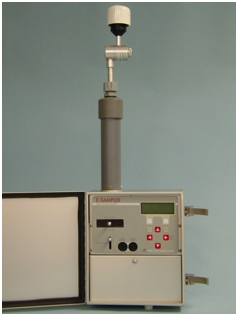Optical Monitoring

Optical monitors which measure light-scattering (nephelometers) or light-absorbing (aethalometers) characteristics of the atmosphere (Figure 10.2). The optical measurement from a nephelometer is called bscat (or back-scatter) which can be converted to an estimate of the concentration of airborne particulates. Optical instruments offer several advantages over gravimetric methods including real-time readings, portability, low power consumption, ease of use, and relatively low cost. Optical instruments have the disadvantage of being generally less accurate than gravimetric instruments at estimating particulate concentration. They are also negatively affected by high relative humidity. Optical instruments are best for projects where real-time or near-real time data is needed, where a high degree of accuracy is not a requirement, and if instrument portability and ruggedness is desirable.
Proper conversion of the light scattering measurement collected by a nephelometer to an estimate of particle concentration ideally involves development of customized conversion equations specific to the monitoring location. Light scattering varies as a function of the relative proportions of fine particles (including smoke) and coarse particles (such as soil dust) which is a unique property of a specific location. As a result, optical instruments may need to be calibrated against a co-located FRM in the same area and pollutant mix, in which they will eventually operate. A formula is then developed to properly convert light scattering to particulate concentration. Some examples of nephelometers that have been used for smoke monitoring include the E-Sampler, DataRAM, MicroDust, and DUSTTRAK.
Nephelometer
A Nephelometer is an instrument for measuring visibility. It collects this data by measuring the amount of light scattered over a known path length and use a mathematical relationship to estimate the aerosol mass concentration.
Aethalometer
An Aethalometer is an instrument that uses optical analysis to determine the mass concentration of Black Carbon particles collected from an air stream passing through a filter. These particles are directly emitted to the air during all combustion, but are primarily associated with coal or diesel smoke. Aethalometers are used by air-quality monitoring programs; public-health protection agencies; research laboratories; and community groups.
Transmissometer
Transmissometers use artificial light sources; either the receiver or reflectors must be placed at one end of a base line and the transmitter at the other end. This fixed base line does not allow flexibility to measure visibility-related variables in different directions. When transmissometers are used in very clean atmospheres, such as class I areas in the Southwest, their critical sensitivity to atmospheric turbulence can introduce error. Additionally, these instruments are usually limited to a single wavelength and not very portable. Transmissometers are used mainly by NPS in Class 1 visibility protection areas.
DATARAM
The DataRam is a compact, self-contained instrument that internally estimates mass concentration from the measured scattering of light. The portable nephelometer can measure particulate concentrations from 0.1 to 400,000 µg/m³, according to the vendor. The instrument continuously displays the current and time-weighted average mass concentration while logging up to 10,000 data points. Data can be downloaded from the instrument through an RS-232 port. The DataRam can be configured with either a PM2.5 or PM10 impactor head to prevent particles larger than 2.5 or 10 µm from entering the optical chamber. For custom calibrations, or to analyze the chemical composition of particulates, the particulates can be collected on a 37-mm filter located in the instrument’s base. An inline heater may also be installed for monitoring in humid conditions (the manufacturer suggests using the heater when the relative humidity is higher than 70 percent). The instrument’s tubular heater is designed to heat the sampled air stream to evaporate liquid water from airborne particles or to eliminate fog droplets. The DataRam is powered by an internal rechargeable battery or by an external dc or ac power source. The DataRam has a built-in, internal calibration device.
Sources: Andy Trent, Mary Ann Davies, Richard Karsky, and Rich Fisher. 2001. Real-Time Smoke Particulate Sampling Fire Storm 2001.
Magee Scientific. 2012. Products: Aethalometer Overview. Accessed on 12 March 2012. Available at http://www.mageesci.com
New Mexico Smoke Management MOU Monitoring Workgroup. 2003. Smoke Monitoring Guide Developed by the New Mexico Smoke Management MOU Monitoring Workgroup. Accessed 11 September 2013. Available at
http://www.frames.gov
ThermoScientific. 2009. Thermo Scientific Particulate Monitor, DataRAM 4 Portable continuous particle sizing monitor/dual wavelength nephelometer. Accessed on 9 September 2013. Available at
http://www.frames.gov
US EPA. 2011.Protecting visibility An EPA Report to Congress. Chapter 3. Accessed on 9 September 2013. Available at
http://www.frames.gov